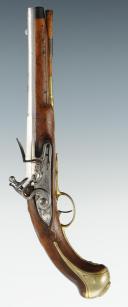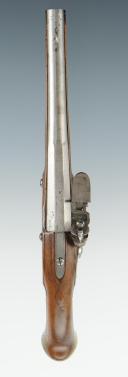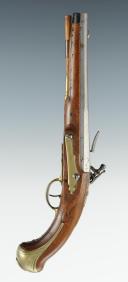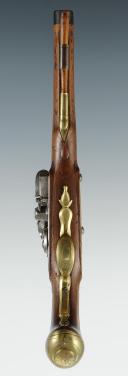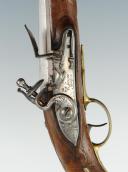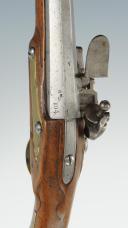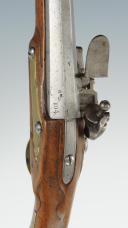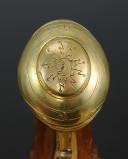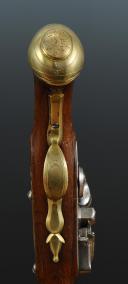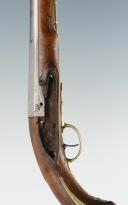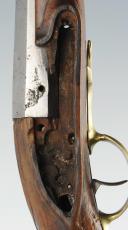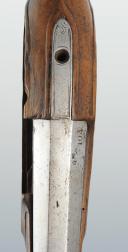
GENDARME PISTOL OF THE ROYAL MILITARY HOUSEHOLD GUARD, MODEL 1763, FORMER MONARCHY.
Sold out
GENDARME PISTOL OF THE KING'S MILITARY HOUSEHOLD GUARD, MODEL 1763, FORMER MONARCHY.
Barrel following the 1733-1734 cavalry model, initially pentagonal then becoming round at the muzzle, marked "104" and stamped with "C.B." under a crown above a fleur-de-lys, bearing the stamp of the controller Claude Bertheas who replaced his uncle Nicolas Carteron, shortened to 26.8 cm in length (the original regulation length being 31 cm), with a slight step at the breech, the total length with the breech being 32.8 cm. Originally, the inscription "Gendarmes de la Garde" was engraved on the upper side of the barrel, a detail that has disappeared on the piece being presented. Stock in walnut following the 1733 cavalry pistol model but featuring fluted decorations surrounding the lock, counter-lock, breech, and ramrod channel. All fittings are in brass following the model of the 1755 model bodyguard pistols, except for the rounded end of the counter-lock. The oval of the pommel is engraved with the emblem of the Guard Gendarmes with thunderbolts falling from the sky. Lock model 1754 signed by the contractor from Saint-Étienne, Simon Jourjon (who completed the 1753 order for the Guard Gendarmes), with decorative engraving and small scrolls at the cocking piece and rear of the lock body; it bears the Saint-Étienne stamp "S.E." under a crown, as well as a "B" stamp of the controller Bonnaud. Non-standard wooden ramrod.
Total length of the pistol: 45 cm.
Caliber: 18 mm.
In very good condition.
France.
Former Monarchy.
PROVENANCE:
From the former collection of Jean BOUDRIOT.
NOTE:
Although shortened and having lost its barrel engraving, this specimen is identical to those held in collections at the Army Museum and in the Ariès collection. It is a rare specimen as the Gendarmes de la Garde company numbered 210 riders, reduced to about 50 riders from 1775 onwards following the measures taken by Saint Germain, ultimately being abolished in 1787. In 1746 and 1747, the Gendarmes were issued rifles. In 1763, the pistols were ordered from the contractor Simon Jourjon; this order was supplemented in 1775 by an additional 50 pairs from Mr. La Tuilerie.
Barrel following the 1733-1734 cavalry model, initially pentagonal then becoming round at the muzzle, marked "104" and stamped with "C.B." under a crown above a fleur-de-lys, bearing the stamp of the controller Claude Bertheas who replaced his uncle Nicolas Carteron, shortened to 26.8 cm in length (the original regulation length being 31 cm), with a slight step at the breech, the total length with the breech being 32.8 cm. Originally, the inscription "Gendarmes de la Garde" was engraved on the upper side of the barrel, a detail that has disappeared on the piece being presented. Stock in walnut following the 1733 cavalry pistol model but featuring fluted decorations surrounding the lock, counter-lock, breech, and ramrod channel. All fittings are in brass following the model of the 1755 model bodyguard pistols, except for the rounded end of the counter-lock. The oval of the pommel is engraved with the emblem of the Guard Gendarmes with thunderbolts falling from the sky. Lock model 1754 signed by the contractor from Saint-Étienne, Simon Jourjon (who completed the 1753 order for the Guard Gendarmes), with decorative engraving and small scrolls at the cocking piece and rear of the lock body; it bears the Saint-Étienne stamp "S.E." under a crown, as well as a "B" stamp of the controller Bonnaud. Non-standard wooden ramrod.
Total length of the pistol: 45 cm.
Caliber: 18 mm.
In very good condition.
France.
Former Monarchy.
PROVENANCE:
From the former collection of Jean BOUDRIOT.
NOTE:
Although shortened and having lost its barrel engraving, this specimen is identical to those held in collections at the Army Museum and in the Ariès collection. It is a rare specimen as the Gendarmes de la Garde company numbered 210 riders, reduced to about 50 riders from 1775 onwards following the measures taken by Saint Germain, ultimately being abolished in 1787. In 1746 and 1747, the Gendarmes were issued rifles. In 1763, the pistols were ordered from the contractor Simon Jourjon; this order was supplemented in 1775 by an additional 50 pairs from Mr. La Tuilerie.
Reference :
7521
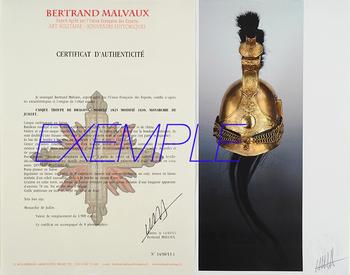
Next update Friday, april 4th at 1:30 PM
FOR ALL PURCHASES, PAYMENT IN MULTIPLE CHECKS POSSIBLE
bertrand.malvaux@wanadoo.fr 06 07 75 74 63
An authenticity certificate of the item including the description published on the site, the period, the sale price, accompanied by one or more color photographs is automatically provided for any item priced over 130 euros. Below this price, each certificate is charged 5 euros.
Only items sold by me are subject to an authenticity certificate, I do not provide any expert reports for items sold by third parties (colleagues or collectors).
